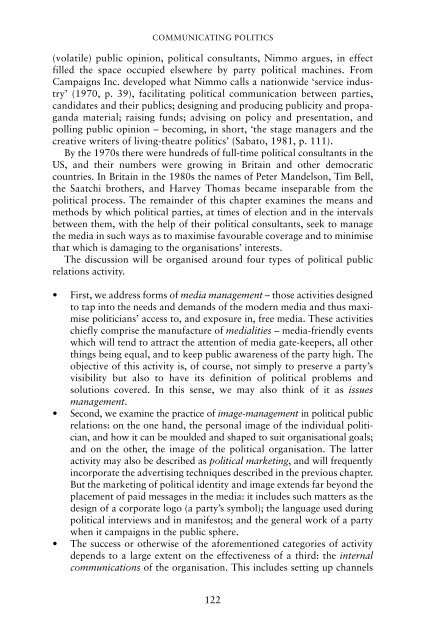20130412164339753295_book_an-introduction-to-political-communication
20130412164339753295_book_an-introduction-to-political-communication
20130412164339753295_book_an-introduction-to-political-communication
Create successful ePaper yourself
Turn your PDF publications into a flip-book with our unique Google optimized e-Paper software.
COMMUNICATING POLITICS<br />
(volatile) public opinion, <strong>political</strong> consult<strong>an</strong>ts, Nimmo argues, in effect<br />
filled the space occupied elsewhere by party <strong>political</strong> machines. From<br />
Campaigns Inc. developed what Nimmo calls a nationwide ‘service industry’<br />
(1970, p. 39), facilitating <strong>political</strong> <strong>communication</strong> between parties,<br />
c<strong>an</strong>didates <strong>an</strong>d their publics; designing <strong>an</strong>d producing publicity <strong>an</strong>d propag<strong>an</strong>da<br />
material; raising funds; advising on policy <strong>an</strong>d presentation, <strong>an</strong>d<br />
polling public opinion – becoming, in short, ‘the stage m<strong>an</strong>agers <strong>an</strong>d the<br />
creative writers of living-theatre politics’ (Saba<strong>to</strong>, 1981, p. 111).<br />
By the 1970s there were hundreds of full-time <strong>political</strong> consult<strong>an</strong>ts in the<br />
US, <strong>an</strong>d their numbers were growing in Britain <strong>an</strong>d other democratic<br />
countries. In Britain in the 1980s the names of Peter M<strong>an</strong>delson, Tim Bell,<br />
the Saatchi brothers, <strong>an</strong>d Harvey Thomas became inseparable from the<br />
<strong>political</strong> process. The remainder of this chapter examines the me<strong>an</strong>s <strong>an</strong>d<br />
methods by which <strong>political</strong> parties, at times of election <strong>an</strong>d in the intervals<br />
between them, with the help of their <strong>political</strong> consult<strong>an</strong>ts, seek <strong>to</strong> m<strong>an</strong>age<br />
the media in such ways as <strong>to</strong> maximise favourable coverage <strong>an</strong>d <strong>to</strong> minimise<br />
that which is damaging <strong>to</strong> the org<strong>an</strong>isations’ interests.<br />
The discussion will be org<strong>an</strong>ised around four types of <strong>political</strong> public<br />
relations activity.<br />
• First, we address forms of media m<strong>an</strong>agement – those activities designed<br />
<strong>to</strong> tap in<strong>to</strong> the needs <strong>an</strong>d dem<strong>an</strong>ds of the modern media <strong>an</strong>d thus maximise<br />
politici<strong>an</strong>s’ access <strong>to</strong>, <strong>an</strong>d exposure in, free media. These activities<br />
chiefly comprise the m<strong>an</strong>ufacture of medialities – media-friendly events<br />
which will tend <strong>to</strong> attract the attention of media gate-keepers, all other<br />
things being equal, <strong>an</strong>d <strong>to</strong> keep public awareness of the party high. The<br />
objective of this activity is, of course, not simply <strong>to</strong> preserve a party’s<br />
visibility but also <strong>to</strong> have its definition of <strong>political</strong> problems <strong>an</strong>d<br />
solutions covered. In this sense, we may also think of it as issues<br />
m<strong>an</strong>agement.<br />
• Second, we examine the practice of image-m<strong>an</strong>agement in <strong>political</strong> public<br />
relations: on the one h<strong>an</strong>d, the personal image of the individual politici<strong>an</strong>,<br />
<strong>an</strong>d how it c<strong>an</strong> be moulded <strong>an</strong>d shaped <strong>to</strong> suit org<strong>an</strong>isational goals;<br />
<strong>an</strong>d on the other, the image of the <strong>political</strong> org<strong>an</strong>isation. The latter<br />
activity may also be described as <strong>political</strong> marketing, <strong>an</strong>d will frequently<br />
incorporate the advertising techniques described in the previous chapter.<br />
But the marketing of <strong>political</strong> identity <strong>an</strong>d image extends far beyond the<br />
placement of paid messages in the media: it includes such matters as the<br />
design of a corporate logo (a party’s symbol); the l<strong>an</strong>guage used during<br />
<strong>political</strong> interviews <strong>an</strong>d in m<strong>an</strong>ifes<strong>to</strong>s; <strong>an</strong>d the general work of a party<br />
when it campaigns in the public sphere.<br />
• The success or otherwise of the aforementioned categories of activity<br />
depends <strong>to</strong> a large extent on the effectiveness of a third: the internal<br />
<strong>communication</strong>s of the org<strong>an</strong>isation. This includes setting up ch<strong>an</strong>nels<br />
122
















